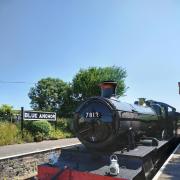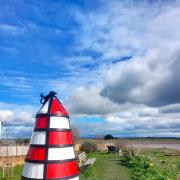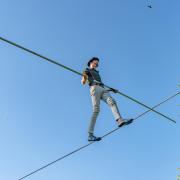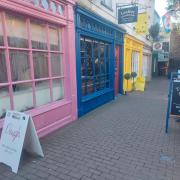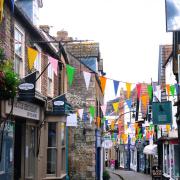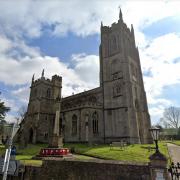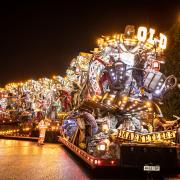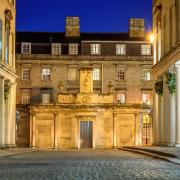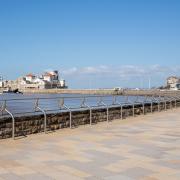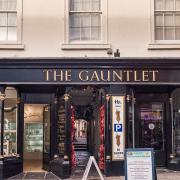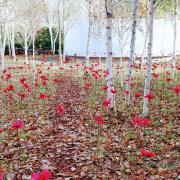Stephen Roberts examines the ancient history of beautiful East Coker

Nobel Prize winner T.S. Eliot (1888-1965) wrote of a beautiful hamstone Somerset village in his poem 'East Coker', the second of his Four Quartets, finished in early-1940. He called it right. The farming village of narrow country lanes has a certain warmth, perhaps because of that amber-tinted stone, the nation's loveliest 'golden lustre', from Ham Hill, some three miles distant. It's quiet in a quintessential English country way.
Eliot's East Coker roots went right back, as it was from here that his ancestors had headed for New England in the 17th century (the 1660s). Apparently, one of them served on the jury at the Salem witch trials. He came here in 1937 to have a look, having discovered his family connection, and last visited in 1939, when he took some pictures.
East Coker was perhaps some kind of old-world idyll for Eliot as the world teetered on the precipice of another world war. He would return one last time. Come January 1965, it would be American-born Eliot's time to have his ashes scattered at St Michael & All Angels, in his adopted village, where he's also commemorated inside with a
wall plaque.
East Coker itself is far more ancient than its Eliot connections, however, as it goes back to Roman times. There were Roman villas in the valley here and portions of the mosaic floors from these are now in the museum in Taunton. A field ('Chesels') near Wraxhill revealed villa remains, including intact mosaics.
East Coker was also mentioned in the Domesday Book (1086). The perpendicular church, which dates from the 12th century, was remodelled by the Victorians, and is Grade II* Listed, one of 80-plus Listed 'features' in East Coker parish. This might be considered the heart of the village, or maybe it's the green ('The Paddock'), just down from the church and almshouses, which could be peppered with daffs or bluebells, depending on the time of year. Whatever you're looking at in the village, you might well bump into an Eliot-admirer. They come here on pilgrimage.

There can't be many villages of this size that have a trio of Grade I Listed buildings. All of East Coker's are privately-owned but are nevertheless visible from public road or footpath. Naish Priory has portions dating back to the 14th century. Hymerford House, at the village's north end, by the mill stream, is 15th century, whilst just south-west of the church is Coker Court, the manor house, which is essentially Tudor. There's a central 15th century hall with perpendicular windows and a robust-looking porch. The east range is later (late-18th century with Venetian windows). Some of this can be viewed from the drive and a row of yews leads from church to manor.
East Coker is not just about manor and church. There are pretty thatched cottages, such as Chapel Cottage and St Roch and other notable buildings like the quaintly-named 17th century Bubspool House. The whitewashed and rather elegant-looking pub, the Helyar Arms, dates to 1491 but was rebuilt in 1834 and is named after the local worthies.
Every village needs a watering hole and hub, incidentally, and East Coker's looks welcoming (it offers B&B by the way if you fancy staying). They cater for visitors here as there's also The Village Café, next to Hymerford House, where this writer, famished and thirsty from exploration, a la Dampier (read on), partook of lunch (and very nice it was too).
William Dampier (1651-1715), reputedly the first Englishmen to set foot in 'New Holland' (Australia) and a discoverer/explorer of those lands before Captain Cook, was born in long, low, thatched Hymerford House. A mariner and explorer, he charted Australia's west coast, circumnavigated the globe on three occasions, wrote Voyage Round the World (1697) and the Discourse on Winds, Tides and Currents. It wasn't all respectable either: he spent some time as a privateer-cum-pirate. As if that wasn't enough, he was pilot (navigator) of the vessel that rescued Alexander Selkirk (the inspiration for Robinson Crusoe). He was baptised at the village church and is also buried there, in an unmarked grave. There's a brass plaque inside telling us more about him. It might not tell you about the words he introduced into our language though, including avocado and chopsticks. Yes, he was that well-travelled. Dampier was wise maybe to go exploring as there was a plague in the 17th century that wiped out much of the village.
That maritime connection is surprisingly strong, given East Coker's landlocked location. There's a lot of premium agricultural land hereabouts, however, used for the production of flax, which was utilised to make sailcloth and rope for the Royal Navy. The Cokers possessed their webbing factories and twineworks. There was a bit of a local industry in these parts, for Crewkerne, just eight miles away, was similarly employed.
The dozen Helyar almshouses at the foot of the path leading to the church are mid-17th century (c1640). They took 20 years to finish because of the distractions of the English Civil War and that plague (1645) and were intended for 11 women and one lucky man. They have gabled dormers, mullioned windows and lofty chimneys: they're characterful and still almshouses to this day. The Helyar family, who built them, lived at Coker Court for hundreds of years. The Helyar Arms recalls them, as does a memorial inside the church, which confirms that they were Lords of the Manor between 1616 and 1947, so from halfway through the reign of James I/VI to the first year of the Cold War.
There can be few villages in the country that can claim to be the final resting place of two such luminaries as Eliot and Dampier. As if that accolade was deemed insufficient, there's also another author and a couple of actors with links to the place. James Bree (1923-2008), an actor, who appeared in On Her Majesty's Secret Service, was born in East Coker.
I'd like to say that there's a full compass set of Cokers in south Somerset, but there isn't. There's a North and West Coker, and, of course, East Coker, which, with all due respect to the others, is the jewel in that particular navigational instrument. You may search for a South Coker, but you won't find it. Wherever you do go, look out for the so-called 'Coker Tunnels' (the sunken lanes of Eliot's 'deep lane shuttered with branches') and also 'Monarchs Way', so-named because King Charles II is said to have fled this way following his defeat at the Battle of Worcester (and ultimately, on to foreign exile).
Having dilly-dallied in East Coker for a bit, I was mindful of Eliot's words: 'In my beginning is my end … in my end is my beginning'. It feels like the kind of place where you contentedly go full circle. Why, after all, would you ever need to go anywhere else?




